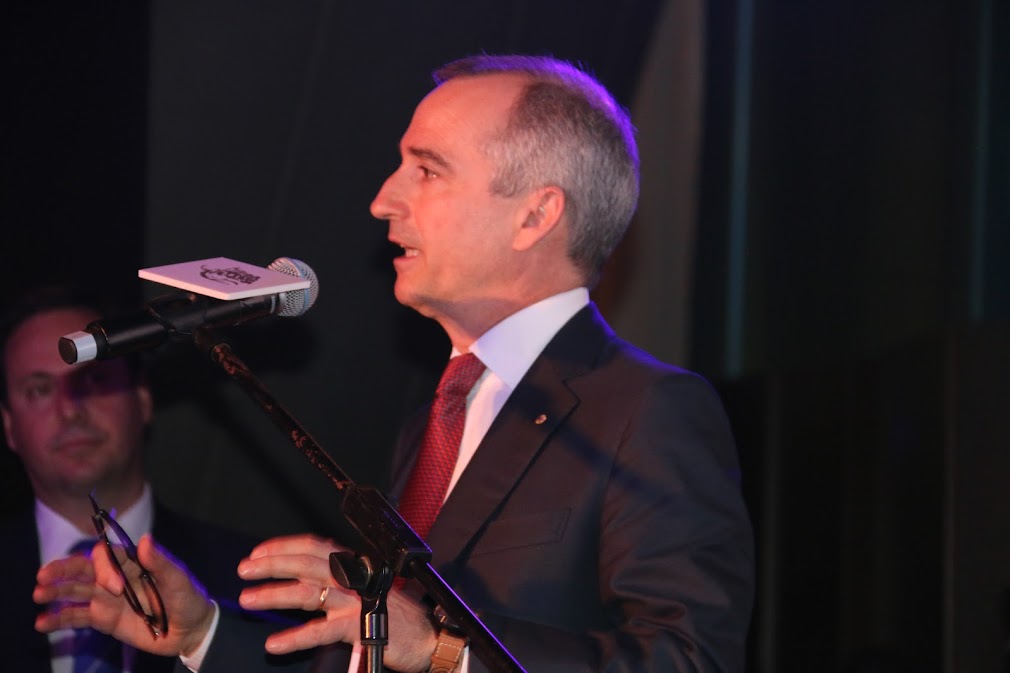IF ANYONE knows the trans-Tasman aviation market well, it’s Qantas Head of International and Freight, Cam Wallace and his newly appointed trade sales chief, Kathryn Robertson. The pair are both long-time Air New Zealand alumni, so it’s little surprise that QF is now turning its attention to the highly trafficked routes between Australia and Aotearoa.
Wallace has been in his new role at Qantas for almost exactly nine months now, and has successfully managed to keep his head below the parapet amid the multiple slings and arrows which the carrier has endured in that time, including the parliamentary public evisceration of other senior executives which ultimately led to the untimely departure of former CEO Alan Joyce.
He’s started to flex his muscles more recently, initiating a reshuffle which saw QF Executive Manager of Global Sales and Distribution, Igor Kwiatkowski, take a new role within Qantas Freight in a move seen by many as aiming to reset the carrier’s relationship with the travel trade. In Kwiatkowski’s place, Kathryn Robertson, who had taken a detour into cruising as Carnival Australia’s Chief Commercial Officer, will return to aviation in the coming months and is tasked with heading up the Qantas domestic and international sales teams.

Both Wallace and Robertson are former Air NZ country managers for Australia, and both were intimately involved in the NZ strategy to target Aussie customers as the Kiwi flag carrier expanded its North American network. There’s no doubt that they have a deep understanding of the potential of the trans-Tasman market, as well as the propensity and opportunity available both for direct and indirect sales to travellers from both sides of what are among the largest tourism markets for each nation.
Meanwhile Virgin Australia and Air New Zealand are eagerly awaiting a decision from the Australian Competition and Consumer Commission about a proposed codeshare agreement which will once again see Virgin be able to sell seats on some of the key trans-Tasman routes it relinquished when it was placed under administration in the early stages of the COVID-19 pandemic almost four years ago now. The stage is clearly set for an intriguing competitive battle.
QF ramping up capacity
After some tweaks earlier this month, upgauging capacity on Brisbane-Wellington by replacing E190s with B737s, Qantas this week ramped things up significantly with additional flights to Australia from Wellington and Christchurch. Interestingly, the move was highly publicised in New Zealand but didn’t seem to rate a mention by Qantas in Australia, despite additional 737 services set to add more than a quarter of a million trans-Tasman seats over the next year or so.
Wallace cited “sustained demand” for the move, noting that Qantas was already flying more people across the Tasman than before the pandemic, with up to 180 return services each week. The capacity expansion announced on Tuesday included Christchurch-Brisbane increasing from daily to up to 12 per week, while Christchurch-Melbourne will also move from daily to 12 per week over the December/January peak period. Wellington-Melbourne will also lift from daily to 10 per week from September this year, with the combined boost set to grow QF’s Tasman capacity by about 7%.
Another factor playing into this strategy may be the intransigence of Auckland Airport, which is determined to push ahead with a major expansion program set to be funded by additional levies and aeronautical charges. Airlines have expressed their vocal opposition to the scope of the project, and Qantas now offering more opportunities to travel from Australia directly to Wellington and Christchurch will eliminate lots of Auckland transits.
Air NZ and Virgin Australia – friends again!
The fractious on-again, off-again relationship between Air New Zealand and Virgin Australia has fascinated aviation watchers for many years. When VA was an Australian public company, at various stages its major shareholders comprised several foreign carriers including Air New Zealand, which at one stage held more than 25% of Virgin Australia. That all fell apart in 2016 during a capital raising and a reported disagreement over strategy between then VA CEO John Borghetti and his Kiwi counterpart, Christopher Luxon (who intriguingly is now the Prime Minister of New Zealand).

The shareholding was part of a wide-ranging alliance between VA and Air NZ implemented in 2010, allowing the carriers to codeshare, offer reciprocal frequent flyer and lounge access benefits and share revenue. Cam Wallace, who at the time of the bust-up was Air NZ Chief Revenue Officer, said the end of the pact would provide other opportunities – a forecast which came true in 2018 when he blindsided NZ’s former Australian partner by engineering a wide-ranging new alliance with Qantas. By late 2019 about 30 Air New Zealand domestic routes began carrying the QF code, while 85 Qantas routes within Australia were also bookable under NZ. The pact doesn’t include the Tasman, however, where Qantas and Air New Zealand remain competitors.
The wheel turned again in November last year when the now private equity-owned Virgin lodged an application with the Australian Competition and Consumer Commission for a unilateral codeshare with Air New Zealand. Under the proposed deal, VA will market and resell Air New Zealand trans-Tasman flights under the Virgin code (excluding VA’s now significantly smaller Tasman footprint which includes a few non-stop leisure-focused routes to and from Queenstown). Air NZ will specify the price at which the itineraries can be marketed and resold by Virgin Australia, and the carriers also plan to cooperate to jointly provide offers to corporate and SME customers.
The application notes that Virgin Australia does not currently have a trans-Tasman offer beyond services to and from Queenstown, leaving it with a”gap in its network offering which has implications not only for the sale of individual trans-Tasman services but also for Virgin Australia’s domestic loyalty proposition and its ability to compete for domestic services and for higher yield corporate and SME customers”.
For its part, Air New Zealand said the proposed pact will drive increased passenger numbers onto its trans-Tasman and domestic services, and also will “facilitate access to additional distribution channels…including to Australian customers where Air NZ does not have as strong a marketing and sales presence”.
NZ and VA had asked the ACCC to make a decision by last month, ahead of a planned commencement in June this year. However after receiving several submissions during a public consultation period, that deadline has already passed – and in contrast to a proposed ACCC timeline, a draft ruling has not even been issued at this stage. The Commission is now flagging a final determination sometime next month.
Industry concerns about the pact
Submissions during the ACCC consultation period included one from the Australian Travel Industry Association, in which CEO Dean Long suggested a condition be imposed to monitor the carriers’ prices and capacity on trans-Tasman routes to ensure a public detriment does not emerge. Long also sought additional details on how VA and NZ intend to cooperate on the proposed joint offers to corporate and SME clients.

Other input came from Queensland Airports Limited, which said it was concerned that allowing the unilateral codeshare may reduce the incentive for Virgin Australia to enter the trans-Tasman market using its own metal, unless a bilateral agreement was secured between the two airlines. Similar issues were raised by Sydney Airport which said the proposed deal “is likely to have a material effect of disincentivising Virgin Australia from recovering trans-Tasman services using its own aircraft and providing much needed competition”.
The New Zealand Airports Association went further, urging the ACCC to decline the application because of its potential to limit competition on the trans-Tasman market. However Canberra Airport came out in favour of the deal because of its potential to boost visitation – but urged a three year authorisation rather than the five years sought, to give Virgin Australia a window in which to develop a detailed proposal to enter the trans-Tasman market with its own fleet.
A further complicating factor is the private equity ownership of Virgin Australia, and the abrupt departure of CEO Jayne Hrdlicka who had previously been mooted as set to lead the organisation through to a public float. Clearly Bain & Co are hoping for an exit sooner rather than later, and perhaps investing in trans-Tasman expansion using VA’s own aircraft may be something not envisaged during the private equity group’s current ownership horizon.
The ACCC has asked VA to substantiate claims in the application that the proposed deal with Air New Zealand will not “act to delay or disincentivise Virgin Australia’s entry on other trans-Tasman routes”. A formal response from the carrier late last month described the opposing submissions as being based on an “irrelevant and wholly unrealistic counterfactual” and cited material public benefits by enabling VA to quickly and efficiently fill the trans-Tasman gap in its network.
Virgin noted that the Qantas Group is still the largest provider of Tasman and domestic Australian services, carrying the majority of corporate travellers across the Tasman and accounting for over 40% of ticket sales and capacity on the New Zealand route. VA also noted other new competition on flights between Australia and New Zealand, including Batik Air and China Eastern, with more carriers operating on the trans-Tasman in January 2024 than pre-pandemic, in January 2020.
Grab the popcorn…
Clearly Virgin Australia and Air New Zealand hope to build their trans-Tasman presence in the face of the growth of Qantas. Indeed the ACCC submission notes that “the Tasman is very important to Virgin Australia’s network offering and ability to compete with Qantas more broadly”. Meanwhile Qantas is likely to press its strong advantage, capitalising on the huge gap in the market left by the withdrawal of Virgin Australia after it was placed into administration.
Buckle up, because this is going to be a heck of a ride.







